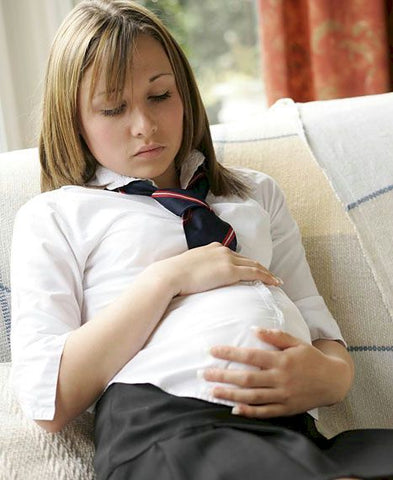 The report, from the U.S. Center for Disease Control and Prevention (CDC) shows that teen birth rates fell at least 15% in all states with the exception of West Virginia and North Dakota during the years 2007 to 2011. Rates in Arizona, Colorado, Idaho, Nevada and Utah fell by 30% or more.By: Alexandra Sifferlin @acsifferlin May 24 2013
The report, from the U.S. Center for Disease Control and Prevention (CDC) shows that teen birth rates fell at least 15% in all states with the exception of West Virginia and North Dakota during the years 2007 to 2011. Rates in Arizona, Colorado, Idaho, Nevada and Utah fell by 30% or more.By: Alexandra Sifferlin @acsifferlin May 24 2013
Teenage pregnancy birth rates in the U.S., which have been declining for two decades, have reached a record low, with significant drops in almost every state.
The CDC based their findings on birth certificates collected during the study period. Overall, the rate of births to teen mothers dropped by 25% from 41.5 per 1,000 teens between the ages of 15 to 19 in 2007 to a record low of 31.1 births per 1,000 teens in 2011. The greatest drops were recorded among Hispanic teens — 34% from 2007 to 2011. Teens from other groups saw steep declines too, with non-Hispanic black teenagers showing a at 24% decline in teen births and non-Hispanic white teenagers a 20% drop. The report, compiled by the National Center for Health Statistics, did not address the reasons behind the decline, but experts say it’s a mix of greater access to birth control and better sex education.
“The short answer is that it is a combination of less sex and more contraception. Teenagers have a greater number of methods of contraceptives to choose from,” says Bill Albert, the chief program officer of The National Campaign to Prevent Teen and Unplanned Pregnancy. “The menu of contraceptive methods has never been longer.”
It’s a validation for public health programs that have advocated safe sex messages and sex education in schools; critics of that strategy raised concerns that such efforts would only promote more sexual activity among adolescents and drive up teen pregnancy rates. Studies do show, however, that more contraceptive options work only if teens understand how to use them appropriately. So quality sex education may partly be responsible for driving down teen birth rates. “When we look at the menu of proven programs, programs that have been shown to actually move the needle, that number has grown over the last years, and to the credit of the federal government, they have invested in it,” says Albert.
The HHS currently recommends 31 evidence-based programs and curricula that are proven to work to prevent teen pregnancy. To establish their effectiveness, the HHS reviewed more than 1,000 studies that analyzed outcomes such as preventing teen pregnancies or births, reducing sexually transmitted infections, or reducing rates of risky behaviors such as having unprotected sex and multiple sex partners.
Programs that focused on reducing not only risky sexual behaviors, but addressing other behaviors such as violence and substance abuse tended to be the most successful. Those that included parents and community interventions were also more effective. “We know from teens themselves that teenagers are much more likely to delay sex and much more likely to use contraception if they feel supported by their parents and have close relationships with their parents. When we ask teenagers directly: who influences your decisions about sex? Surprise. Year after year after year they say parents,” says Albert. And even efforts to educate adolescents about healthy living behaviors that involved nutritional education and physical activity were useful in improving teens’ overall awareness of their health and sexual health.
Some teen pregnancy prevention programs, like the Denver Health and Hospital Authority’s Wyman’s Teen Outreach Program (TOP), have embraced social media to promote their message. TOP supplements their nine-month youth development invention and community service program with text messages that corresponded to lessons taught that week in the program.
Other cultural trends may also be contributing to the trend. More people are getting married later and putting off starting a family, and it’s possible that teens are mirroring what they see in their own families or their friends’ families. The report also gathered data from the middle of the downturn in the U.S. economy, and recessions typically lead to some slow down in birth rates. “I do understand that most teens are not checking their 401Ks, but it is reasonable to say that teens are very keen at observing the world around them. I think that it can have a somewhat sobering effecting on teenagers,” says Albert.
If that’s the case, then another cultural phenomena — putting teenage mothers on reality TV shows like “16 and Pregnant” and “Teen Mom” — may also be exerting it’s own form of birth control. In a survey commissioned by the The National Campaign to Prevent Teen and Unplanned Pregnancy, researchers at the University of North Carolina at Chapel Hill (UNC) and Durham, N.C., research firm iRT separated 162 teens from Boys and Girls Clubs in North Carolina into a group that watched three episodes of “16 and Pregnant” and a group that did not. They also polled 1,008 teens about whether they watched the shows. Both of the teens from the viewing study and the polled teens reported that watching the show made pregnancy more real to them, and 82% of the teens who watched said the shows gave them a better understanding of the challenges of being pregnant and of parenting, and how to avoid it.
Despite this gains in reducing teen pregnancy and birth rates, however, some argue that sex education still has a way to go in the U.S., and some methods have been criticized as ineffective, or counter-productive. For example, a recent New York City subway poster campaign that featured pictures of crying toddlers with the message, ““Honestly Mom…chances are he won’t stay with you. What happens to me?” was ridiculed for shaming teens into acting responsibly, a tactic that hasn’t always proven effective.
Not every public health campaign may hit home with teens, but at least the data suggest that most of them, and as well as the sex education programs that are becoming a part of school curricula, seem to having an impact.
For advice on how to talk to kids about making responsible choices about sex, see the CDC’s recommendations.
Alexandra Sifferlin@acsifferlin
RipnRoll condom store, seen on...





RipNRoll Condoms
Author
RipNRoll has been a pioneer of the condom industry since 1996. Viewed worldwide as a critically acclaimed Condom Company, Rip n Roll® presents a non-pornographic approach to safety, sex education and guidance.